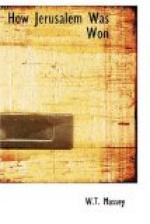The night of December 27-28 was without incident. The Turk had staked and lost, and he spent the night in making new dispositions to meet what he must have realised was being prepared for him on the following day.
It is doubtful whether there was a more successful day for our Army in the Palestine campaign than December 27. The portion of our line which was on the defensive had stood an absolutely unmovable wall, against which the enemy had battered himself to pieces. Our left, or attacking sector, had gained all their objectives against strong opposition in a most difficult country, and had drawn against them the very troops held in reserve for the main attack on Jerusalem. The physical powers of some of our attacking troops were tried highly. One position captured by the 229th Brigade was a particularly bad hill. The slope up which the infantry had to advance was a series of almost perpendicular terraces, and the riflemen could only make the ascent by climbing up each others’ backs. When dismounted yeomen secured another hill some men carrying up supplies took two hours to walk from the base of the hill to the summit. The trials of the infantry were shared by the artillery. What surprises every one who has been over the route taken by the 10th and 74th Divisions is that any guns except those with the mountain batteries were able to get into action. The road work of engineers and the 5th Royal Irish Regiment (Pioneers) was magnificent, and they made a way where none seemed possible; but though these roadmakers put their backs into their tasks, it was only by the untiring energies of the gunners and drivers that artillery was got up to support the infantry. The guns were brought into action well ahead of the roads, and were man-hauled for considerable distances. Two howitzers and one field gun were kept up with the infantry on the first day of the advance where no horses could get a foothold, and the manner in which the gunners hauled the guns through deep ravines and up seemingly unclimbable hills constituted a wonderful physical achievement. The artillery were called upon to continue their arduous work on the 28th and 29th under conditions of ground which were even more appalling than those met with on the 27th. The whole country was devoid of any road better than a goat track, and the ravines became deeper and the hills more precipitous. In some places, particularly on the 10th Division front, the infantry went forward at a remarkable pace; but guns moved up with them, and by keeping down the fire of machine guns dotted about on every hill, performed services which earned the riflemen’s warm praise. The 9th and 10th Mountain Batteries were attached to the 10th Division, but field and howitzer batteries were also well up. On the 28th the 53rd Division bit farther into the enemy’s line in order to cover the right of the 60th Division, which was to continue its advance up the Nablus road towards Bireh. The 158th Brigade captured Anata, and after fighting all day the 1/7th Royal Welsh Fusiliers secured Ras Urkub es Suffa, a forbidding-looking height towering above the storm-rent sides of the wadi Ruabeh. The 1/1st Herefords after dark took Kh. Almit.




